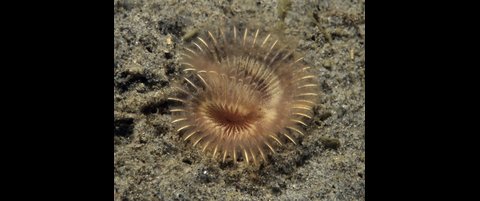
Comparing the Sabellid fan worm with its fellow aquatic worms can give us a deeper understanding of how these creatures adapt to their surroundings. Think of it like comparing different styles of art. Each has its unique qualities and techniques, but they all share a purpose: survival in a dynamic ecosystem. In this article, we’ll take a closer look at the characteristics of the Sabellid fan worm and compare it to a few other worms you might find in the same neighborhood of the ocean floor.
What is a Sabellid Fan Worm?
The Sabellid fan worm belongs to the family Sabellidae, which includes many species known for their striking fan-like structures. These creatures are often found in shallow waters, where they use their feathered appendages to filter feed on plankton and other tiny particles. The tube they build serves as a cozy home, protecting them from predators and strong currents.
You might be wondering how exactly these worms create their tubes. They secrete a mucous that binds sand grains and smaller materials together, forming a sturdy shelter. This ingenious method allows them to create homes that not only provide safety but also help them thrive in diverse marine environments.
What’s fascinating about Sabellid fan worms is their vibrant colors and unique patterns. Each species can vary significantly, with some sporting bright yellows, reds, or even greens. This stunning diversity not only makes them a joy to observe but also plays a role in their survival—a colorful appearance can deter potential predators.
Similar Worm Species: The Polychaetes
While the Sabellid fan worm is quite remarkable, it’s not the only player in the marine worm scene. The Polychaetes are a large group of segmented worms that share many similarities with Sabellids. These worms are characterized by bristle-like structures called chaetae, which help them move and burrow in sediment.
Polychaetes come in a variety of forms, some of which resemble the Sabellid fan worm with their elaborate structures and feeding methods. For instance, species like the Terebellid worms can also filter feed but often inhabit sandy or muddy substrates. They have long bodies that can extend into the water column to catch food, much like the fan worms.
Interestingly, Polychaetes generally have a more complex lifestyle, meaning that while some may filter feed, others might be active predators. This adaptability allows them to occupy various ecological niches, making them quite successful in different marine environments.
How They Differ: Feeding Mechanisms
One of the main differences between the Sabellid fan worm and other similar worms lies in their feeding techniques. Sabellid fan worms are primarily filter feeders, meaning they capture particles suspended in the water. Their fan-like appendages sweep food particles toward their mouths, which is an efficient way to gather nourishment without expending too much energy.
In contrast, other Polychaete worms may be more opportunistic. For example, the Nereid worm, another type of Polychaete, is known for its ability to consume larger prey. Nereids can actively hunt and scavenge, making them less dependent on the nutrient-rich waters that Sabellids rely on. This difference in feeding strategies highlights how diverse the adaptations can be among worms sharing the same habitat.
Moreover, the physical structure of their feeding appendages varies. While Sabellid fan worms have beautifully branched structures for capturing microplankton, many Polychaetes possess more straightforward setups that enable them to tackle a wider variety of food sources.
Habitat Preferences: Where They Live
When it comes to habitats, both Sabellid fan worms and similar Polychaete species can be found in sandy bottoms, coral reefs, and even rocky areas. However, the Sabellid fan worm tends to prefer calmer waters. Their tube homes provide stability in changing currents, and they thrive where sediment is abundant, allowing for effective tube construction.
On the other hand, some Polychaetes like the Lumbrinerids can adapt to a more diverse range of conditions. They may inhabit more turbulent environments and are often found in deeper waters. Their ability to burrow and navigate through varying sediment types helps them thrive even when conditions aren’t ideal for other worms.
This difference in habitat preference speaks to the adaptability of these species. While Sabellid fan worms might be the more delicate flower, Polychaetes often have the versatility of sturdy weeds, flourishing in various environments.
Reproduction: A Closer Look
Reproductive strategies also set these worms apart. Sabellid fan worms generally reproduce through broadcast spawning. During spawning season, both males and females release their gametes into the water, allowing fertilization to happen externally. This method increases genetic diversity but also means that many offspring may not survive due to predation.
In contrast, some Polychaete species engage in different reproductive tactics. For example, some can reproduce asexually through fragmentation, where a portion of the worm can regenerate into a new individual. This can be advantageous in stable environments, where it ensures the survival of the species even when conditions are less than favorable.
Understanding these reproductive strategies offers insight into how different species have adapted to ensure their survival. It’s a fascinating world of life cycles that connects back to how we perceive these creatures in their environments.
Comparing the Sabellid fan worm to similar worm species really highlights the beauty and diversity of life underwater. By understanding their differences in feeding, habitat preferences, and reproductive strategies, we gain a deeper appreciation for the complex relationships that exist in marine ecosystems.
Both the Sabellid fan worm and its Polychaete counterparts play vital roles in their environments. They contribute to the food web, help in sediment turnover, and even promote the health of coral reefs. So, the next time you observe these magnificent creatures, remember that each has its unique story and vital role in the tapestry of ocean life.
Exploring and comparing these species not only enriches our knowledge of marine biology but also encourages a greater appreciation for the fragile ecosystems that they inhabit. You might even find yourself drawn into the world of marine life, eager to learn more about these incredible organisms!
